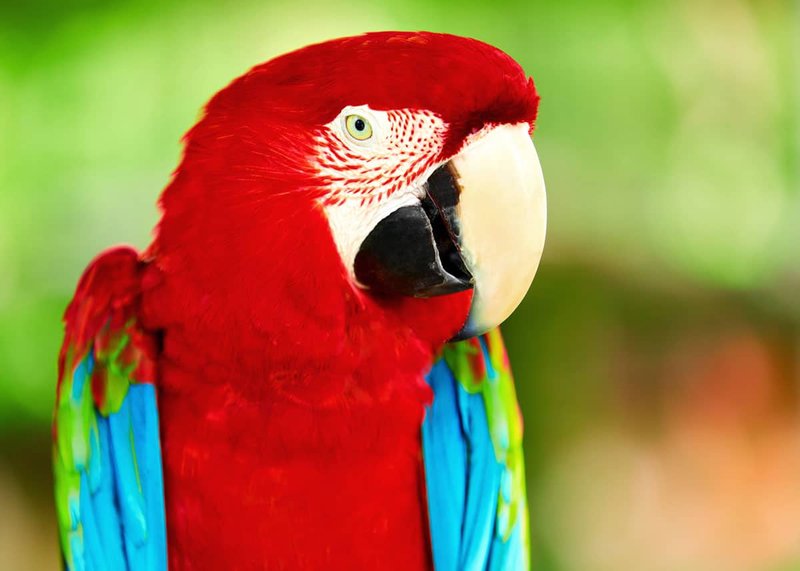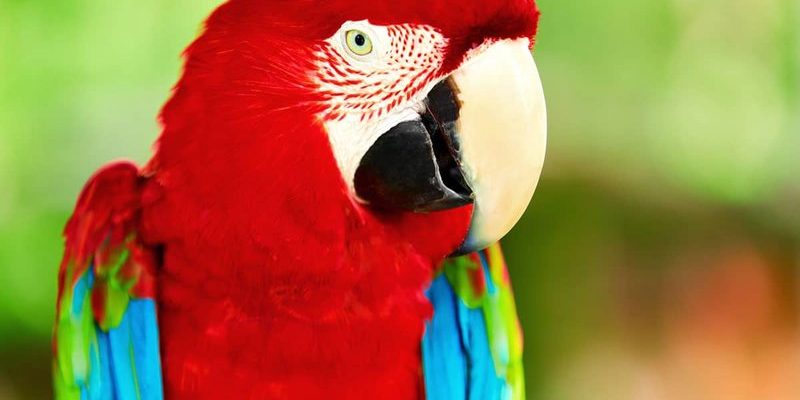
But there’s more to these magnificent birds than just their looks. You might be surprised to learn about their behaviors, diets, and social structures. As one of the most recognizable parrot species, they have fascinating stories that make them stand out in the avian world. So let me take you on a journey to explore 10 things you might not know about the scarlet macaw. You’ll gain insight that could deepen your appreciation for these incredible birds!
1. Their Colorful Feathers Serve More Than Just Looks
You might think the scarlet macaw’s bright feathers are just for show, but they actually play an important role in their survival. The vivid colors help them camouflage among the vibrant fruits and flowers in their native rainforests. When perched high in the trees, they blend in with their surroundings, making it harder for predators to spot them.
But there’s more! Their feathers also communicate emotions and status among other macaws. If a scarlet macaw is feeling bold or wants to assert dominance, it might puff up its feathers, displaying its brilliant colors more prominently. It’s like their way of putting on a show!
2. Their Diet Is Diverse and Nutrient-Rich
Let’s talk food! Scarlet macaws are primarily frugivores, meaning they love to munch on fruits. But their diet goes beyond just fruit; they also enjoy seeds, nuts, and flowers. Imagine foraging in the wild for a buffet of fresh goodies—this is a daily adventure for them!
Interestingly, they often consume clay from riverbanks. You might wonder why they’re eating dirt, right? This clay helps neutralize toxins in their diet and provides essential minerals. So, while that seems odd to us, it’s a crucial part of their health routine.
3. They’re Highly Social Creatures
Scarlet macaws aren’t the solitary type. In fact, they thrive in social groups! These birds are known to form strong bonds with their mates and even their flock members. You could say they’re the life of the party.
They use a variety of vocalizations to communicate with each other—screeches, squawks, and whistles. Picture a lively chat over coffee; that’s how they interact! This social nature not only helps them stay safe but also keeps their spirits high in the sometimes lonely expanses of the rainforest.
4. Their Lifespan Is Impressive
You might be surprised to learn that scarlet macaws can live for 50 years or more in the wild. In captivity, they can even reach up to 75 years, given the right care. This long lifespan means they can form lifelong bonds with their human companions if they’re kept as pets.
However, caring for a scarlet macaw over such a long time isn’t a commitment to take lightly. They require a lot of attention, mental stimulation, and space to thrive. In many ways, nurturing a scarlet macaw is akin to caring for a toddler—lots of love and responsibility involved!
5. They Have Impressive Intelligence
Scarlet macaws are no dummies! They’re incredibly smart and can solve problems, learn tricks, and even mimic human speech. Imagine having a feathered friend who can chat with you—that’s the magic of their intelligence.
Their cognitive abilities allow them to engage in complex social interactions and adapt to new environments. Just like a curious child, they explore their world, pushing boundaries to understand how things work. This intelligence makes them fascinating pets, but it also means they need constant mental stimulation to keep boredom at bay.
6. They Play a Critical Role in Their Ecosystem
Scarlet macaws are more than just pretty faces—they’re vital to their ecosystem. As they munch on a variety of fruits, they play a key part in the fertilization of plants through their droppings. This means they help keep the forest healthy and thriving!
By spreading seeds across vast areas, they assist in the growth of new plants. It’s like they’re little gardeners of the rainforest, unintentionally ensuring the survival of their habitat. So, when you see a scarlet macaw, remember that it’s doing its part to maintain the delicate balance of nature.
7. They Have Unique Mating Rituals
Scarlet macaws are monogamous, meaning they typically pair up for life. Their courtship rituals are quite elaborate, often involving mutual preening and playful behaviors. Can you picture it? Two macaws grooming each other, building trust and affection as they prepare for a lifetime together.
The pair also work together to create a nest, usually in tree cavities. They’re incredibly protective of their young, working as a team to raise them. It’s heartwarming to see how dedicated these birds are to each other and their family—that’s true love in the avian realm!
8. Their Habitat Is Threatened
Unfortunately, scarlet macaws face significant threats from habitat destruction, illegal trapping, and the pet trade. Their habitats are often cleared for agriculture, which means fewer trees for nesting and foraging. Did you know that they rely on large expanses of rainforest to thrive? As we encroach into their world, we jeopardize their future.
Conservation efforts are crucial to ensuring these magnificent birds can continue to thrive. Various organizations are working to protect their habitats and educate people about the importance of preserving these colorful gems. It’s a tough battle, but every little effort counts!
9. Their Wing Span Is Impressive
Scarlet macaws are large birds, boasting wingspans that can reach up to 3 feet! This size, coupled with their powerful flight muscles, allows them to soar gracefully through the trees. Just imagine watching one take off—it’s like seeing a piece of the rainbow lift into the sky.
This impressive wingspan aids in their long-distance travel, as they often fly in search of food and nesting sites. Seeing them gliding overhead is a vivid reminder of the beauty of nature and the freedom these birds embody.
10. They’re More Than Just Pets
While many people adore having scarlet macaws as pets, it’s important to recognize that they are more than just beautiful companions. They require commitment, understanding, and an environment that mimics their natural habitats. That means lots of space to roam, toys to play with, and time spent together.
You might be wondering if a scarlet macaw is right for you. Honestly, they can be joyful additions to the family—but they also come with responsibilities. If you provide the necessary care, they can become lifelong friends. It’s like welcoming a vibrant personality into your home, one that requires nurturing and love.
In conclusion, the scarlet macaw is a remarkable bird with a lot to offer, from its striking colors to its social nature and intelligence. Understanding these birds a little better enhances our appreciation for them. So, whether you’re admiring them in the wild or considering them as pets, these facts can help deepen your respect for these extraordinary creatures. Remember, every time you see a scarlet macaw, you’re witnessing a unique blend of beauty, intelligence, and the call for conservation in the wild.

